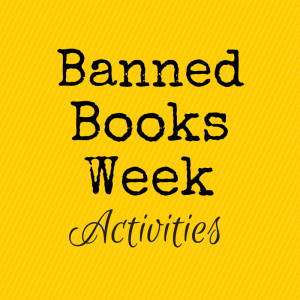Banned Books Week is almost here! According to the Banned Books Week website, Banned Books Week began in 1982 "in response to a sudden surge in the number of challenges to books in schools, bookstores and libraries."
Banned Books Week draws attention to the issue of censorship and the freedom to choose reading materials.
An increasing number of school libraries are participating in Banned Books Week, so I thought it would be great to share some ideas. I found some fantastic Banned Books displays and Banned Books bulletin boards on Pinterest. Check out my Banned Books Week Pinterest board.
Need some activities for Banned Books Week? You can check out these free activities.



I set up a cart or display. I grab our best books/challenged books. I individually wrap each book with construction paper leaving the spine uncovered and label "Banned." I have Caution tape that I wrap around my display.
It gets everyone's attention. They want to know which books are banned, and why. We read the reasons why the books were challenged. My personal favorite moments are the disbelief on their faces after discovering why the books were challenged. Priceless.
I talk with 5th and 6th graders about how each family has their own rules, and that's ok. Food to eat, what to wear, hair cuts, tv, movies they can see, time to go to bed, etc. , BUT that it doesn't mean that they should be able to tell other families what they can do. It opens up a great dialogue. It's about individual choice. That other countries burn books, and that we have freedom of speech here (well sort of) and we need to honor that. I also point out, and the kids always laugh, that some people think they're not smart enough to know when something is fantasy, like Harry Potter. I talk about why some individual books have been banned and they're always shocked. I remind them, as adults later, they can read anything and should...
I rotate through a few different activities with my fifth and sixth graders. For one, I put a good number of banned/challenged books on display (25 or 30) that fit their age group. I try to make sure that they are fairly well known books. I ask them to guess what they have in common (other than physical characteristics of books..yes, I have to do that). No one can ever guess; I wind up telling them. Then I have a matching sheet for the top ten most well known books - they need to match the title with the reason it was banned. I don't always put up the most obvious reason. For example, witchcraft/magic/occult is the reason for several books on the list, so for Harry Potter I put down 'Anti-family.' Which is one of the reasons it's been challenged. We go through the list as a class, and then they get into small groups of 3-4, and discuss the reasons, what they think of them, if they agree with it being banned or not, etc. Then I lead a discussion about it. However, I'm thinking of changing the last bit to some sort of small poster they would work on in their groups, but I haven't worked out details.
Another activity I do is read an article to them about an actual event that happened in our state. An elderly woman took a copy of a sex ed book out of her local library and out of the neighboring town, and refused to return it. She sent a letter to both libraries detailing her objections, that she wouldn't return it, and enclosed a check. I ask the students if what she did was stealing, and we discuss their thoughts.
The last activity I do is to pass out a banned/challenged picture book to pairs of students, and let them go through their book, looking for why it might have been banned. Sometimes they can figure it out. Other times, they can't. This is another one I want to do more with - have them research their book on their own perhaps, jave them do up a flier or advertisement warning people away or trying to convince them to read it, in spite of the bad press its gotten.
Any suggestions from other readers would be welcome, and I'll look forward to seeing what others do.